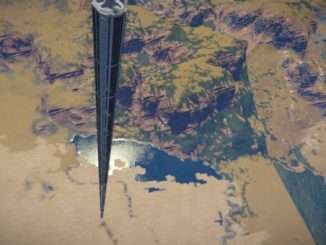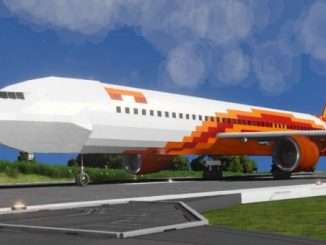
This structure description should provide guide to classify various small grid combat vessels into correct categories. Ravien Superdrive (branch of Ravien Industrial Corporate) uses this structure to describe their products. Customers can see, what capabilities will they get with the vessel of their choice.
Contents
Patrol Drone [PD]
Сrеdit gоеs to Tyro !
Light, lightly armored drone used for patrolling around station or capital ship.
Expected capabilities
This machine should be able to be active for long periods of time. It should be able to patrol around a selected point, and return to home base for refueling and rearming when needed.
In case of combat engagement, this drone should attack enemy personnel or light vessels. This first line of defense should prevent enemy forces from commencing an infantry attack, and slow down light attacks.
Armor
Only light armor. Since this vessel should act mostly as a deterrent force.
Armament
Anything heavier than standard Gatling machine guns would be a waste of resources. There could be reasons to use heavier armament, but usually machine guns are universal, light, and with great ammo capacity.
Propulsion
This vessel should be able to patrol over a long period of time. Therefore, electricity is recommended to be used as a propellant.
Equipment
This vessel depends on AI blocks, therefore Offensive AI must be implemented. There should be event controllers to check ammo and energy status, task blocks for safe return, and also recorder blocks to set landing and taking off.
Attack Drone [AD]
Unlike the Patrol Drone, the Attack variant should be released only when the enemy is in range. Heavier than Patrol Drones, ADs should use the moment of surprise and hit enemies while those are occupied by PDs from the first line of defense.
Expected capabilities
AD should be able to automatically take off when needed, engage the enemy and then return if the enemy has been defeated, or in case of ammo/fuel shortage.
Armor
AD, like PD, should depend on smaller size rather than extensive armor. There can be zones, however, which are protected by heavy blocks. Increased weight is only a small price if the AD can survive longer and therefore be more effective.
Armament
Autocannons are recommended, because they provide great punch in a small package. In this case, limited ammo storage is not really an issue. These models should be able to get back to base, rearm and refuel and engage the enemy again.
Propulsion
Hydrogen is recommended, because ADs must be able to react swiftly, return to the base when needed,
Equipment
A beacon, or antenna, are suggested for locating damaged drones, which are unable to return to the home base.
Remote-Controlled Fighter [RCF]
RCFs are especially useful if a base suffers from lack of manpower. These fighters are expendable and can be used against stronger enemy without the need of the pilot sitting in the machine.
Expected capabilities
The antenna of RCF must be well protected as it is the only connection to the pilot. Other than that, RCF acts as regular fighter in most cases. It is not advised to implement any complex weapons and systems as the capability to control the RCF, as well as the vision and situational awareness, is reduced.
Fighter [F]
Base tool for local defense. Should be light and cheap. Its value lays in the possibility of mass production and high readiness, because no complex systems must be maintained before a deployment.
Expected capabilities
The fighter should be able to engage a fast moving target, therefore it should have enough fuel to fight properly before being supported by other vessels, or destroyed.
Armor
Only a light armor is recommended, as a fighter should be cheap and replaceable. This machine will never be protected well enough because of its limited size, so it is better to reduce quality in order to raise quantity.
Armament
Fighters should be effective against enemy troops and the lightest vessels (RCFs, Fighters, Drones…). Therefore, a Gatling machine gun is the weapon of choice for a fighter. Because of the capacity of a Gatling machine gun, a cargo space on the fighter is not an issue.
Propulsion
Both ion and hydrogen are somewhat possible to be used on space fighter, both having its own issues. Ion propulsion won’t provide enough thrust to be properly maneuverable, but will provide enough flight time even for more complex tasks. This is not the case with hydrogen. Hydrogen fighters will be much more dependent on local supplies, as well as replacing on the front line in quick pace.
Equipment
No special equipment is needed. Some cargo space is recommended. One nice-to-have piece of equipment for a hydrogen fighter to have is an O2/H2 generator. Even though not necessary, it can provide means of refueling, together with life support. It mostly depends on a task for which the fighter is built.
Interceptor [IC]
Heavier than fighters, ICs should be able to hit hard. Those vessels should be able to stop a small grid vessel of any size.
Expected capabilities
ICs should be deployed locally. That means that there are no concerns about range, or life support systems. ICs are mostly flying guns.
Armor
An IC should withstand defensive fire from an enemy vessel (bomber-like). Therefore, it is possible to reinforce frontal zones with a few heavy armor blocks. This should not reduce the acceleration potential, however. ICs have to intercept the enemy in first place.
Armament
Autocannons all the way. They are absolutely deadly against small grid vessels. And since IC is bigger than a fighter, it can carry enough of them not to consider their lower RoF as an issue.
Propulsion
The only case where the hydrogen is not the first choice, is atmospheric IC. Atmospheric thrusters are very effective, so it is debatable if IC should be able to be deployed in both atmosphere and space.
Equipment
No special equipment required. Bigger cargo space should be considered because of large autocannon ammo magazines.
Defender [DF]
Defender can be described as a small grid corvette, mainly because of extensive use of turrets, together with limited use of stationary weapons.
Expected capabilities
Defender should be able to engage multiple light targets in multiple directions at once. It is the wall enemies should smash against. A defender deployed in the middle of an enemy drone hive should be able to withstand enemy fire, reduce their numbers, and most importantly, buy time for other forces to engage more valuable targets.
Armor
The defender should be maneuverable, as well as durable. Therefore, it is crucial to find the sweet spot between armor and acceleration. Since light armor is hopelessly ineffective against Gatling machine guns, heavier armor should be used mostly for sides of the vessel because of presumed fire zones.
Armament
Gatling and autocannon turrets should be combined. Anything heavier is debatable, but both missile and assault cannon turrets can be deadly against small grid vessels. The final decision will be deeply related to the overall size of the Defender type vessel.
Propulsion
There are reasons to use any type of propulsion. It depends on the philosophy of the designer, as well as availability of materials and supplies for a given type of propulsion.
Equipment
Defenders should have spare functional blocks, because there is assumption that it will be hit. Cargo block should be well hidden and protected. The same is applicable for hydrogen tanks, even though they are much more durable against small weapon fire.
Strike Fighter [SF]
Strike fighters are the most universal of all types in this list. They can blow a heavy hit to large vessels, as well as dogfight smaller adversaries.
Expected capabilities
Against large grid vessels, SFs should be able to threaten the enemy from the distance, use their maneuverability to be in the perfect position to reduce enemy defensive capabilities before engaging them on small distance.
In a dogfight, smaller size, compared with decent firepower, should provide an SF means to destroy enemy fighters and drones.
Armor
Because of its fighter role, heavy armor cannot be recommended, as it can severely reduce the maneuverability. The less armor, the better.
Armament
Assault cannon or rail guns should be used for its strike capabilities. These weapons have great range as well as good destructive potential.
As a fighter, it should follow the basics for standard fighters – Gatling machine guns cheap, have great capacity, and are somewhat effective.
Autocannons could be a good choice for both roles, wouldn’t they obstruct the pilot’s view with huge smoke clouds. This is not really an issue for interceptors, them engaging one primary target at a given time. But for an SF, it is possible to engage a big freighter, for example, while having to deal with its defensive drones and fighters. Situational awareness in this situation is the key for survival.
Propulsion
No clear winner in this category, but hydrogen is the most universal, therefore suitable for the most universal type of small grid vessel.
Equipment
This type of vessel is almost ideal to be equipped with guided missiles. These can provide the much-needed capability to engage multiple targets at once.
Big cargo capacity is needed to carry good amount of rounds for all weapons.
Interdictor [ID]
Interdictor is the only type in this list to be deployed behind enemy lines and act independently. If the Defender type is meant as a some type of corvette, the interdictor should act as a mini-cruiser.
Expected capabilities
ID should be able to act independently, deal with any small grid threats, and run from any large grid obstacles. These capabilities require a variety of weapon systems and equipment.
Armor
This vessel cannot depend on shipyard or carrier to help in case of damage. It is recommended to use proper plating over vital parts of the ship. Interdictor should be quite large vessel, so it should carry some weight without reduction of its capabilities.
Armament
Interdictors can meet fighters, defenders, drones, large grid turrets. And they should be able to deal with all of that. There is not really any type of weapon these vessels should not use, even though assault cannon turrets being somewhat questionable. Stationary assault cannons can do similar things on a small grid vessel, which is much more maneuverable than the large grid adversaries.
Propulsion
Combination of hydrogen with proper electric propulsion (atmospheric in atmosphere, ion in space) is recommended. IDs should not be dependent on supply lines, so ice can be a scarce commodity.
Equipment
A survival kit, life support blocks – those should be implemented into the design. Proper cargo and fuel capacity should provide resources for long distances and numerous encounters with the enemy.
Guided missiles are recommended as those can provide new range of capabilities.





Be the first to comment